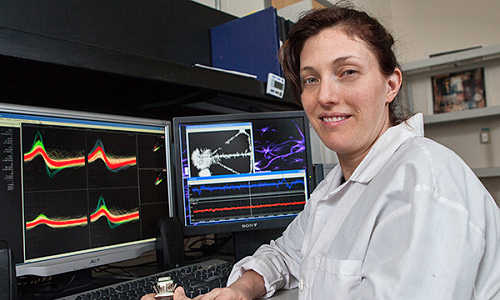Amy Griffin, associate professor of psychological and brain sciences at the University of Delaware, has received a five-year, $1.78 million grant from the National Institute of Mental Health to support her research into the brain mechanisms of working memory.
A neuroscientist, Griffin has been interested for some time in the interaction between the prefrontal cortex, located at the front of the brain, and the hippocampus, a region in the temporal lobe of the brain. When the two areas fail to work together, that failure appears to be correlated with deficits in working memory, a condition that commonly occurs in schizophrenia, general anxiety and other psychiatric disorders.
The hippocampus is the portion of the brain responsible for memory, while the prefrontal cortex controls executive function, a term that includes such cognitive abilities as problem-solving, planning and abstract thinking.
“These are two areas of the brain that are far apart, but their oscillations [rhythmic activities] are synchronized,” Griffin said. “When one area is active, so is the other.”
Working memory, sometimes called short-term memory, is “the kind of memory that fails when you walk into a room and forget why you came there,” she said.
When the oscillations in the hippocampus and prefrontal cortex are out of sync, deficits of working memory occur. In those cases, Griffin said, “both regions are active, but they’re not talking to each other.” The mechanism that causes that lack of communication has not been well explored, and her research will seek to do that.
Griffin and her research team plan to conduct two types of experiments. One will inhibit activity in a brain region called the nucleus reuniens, a region that is hypothesized to synchronize the hippocampus and prefrontal cortex and is expected to cause impairments with working memory. In the other experiment, researchers will activate the nucleus reuniens to increase synchrony, hoping to learn if that improves working memory.
The research will employ a cutting-edge technique called optogenetics, a process that uses proteins to make neurons sensitive to light and then uses light to control them.
“Optogenetics is becoming a common technique,” Griffin said. “It’s a way to study these processes on a millisecond timescale.”
A 2013 article in the journal Nature Neuroscience said optogenetics “is transforming the field of neuroscience. For the first time, it is now possible to use light to both trigger and silence activity in genetically defined populations of neurons with millisecond precision.”
Griffin, using a rat model, will inject the light-sensitizing substance — a harmless virus — into the nucleus reuniens and then use a laser to inhibit or activate this brain region. The rats then perform tasks that assess their working memory. Synchronization between the hippocampus and prefrontal cortex will also be recorded, with the prediction that the degree of the working memory impairment will be correlated with reductions in synchrony.
“Our experiments will not be interfering with the activities of the hippocampus or the prefrontal cortex within themselves,” Griffin said. “We want to affect only the ability of the structures to talk to each other.”
Story Source:
The above story is based on materials provided by University of Delaware, Ann Manser





